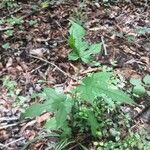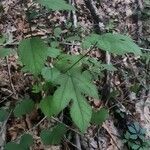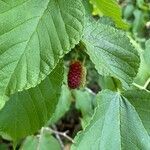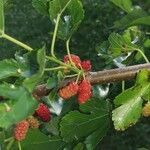Shrubs or trees , to 20 m. Bark gray-brown with orange tint, furrows shallow, ridges flat, broad. Branchlets red-brown to light greenish brown, glabrous or with a few trichomes; lenticels light colored, elliptic, prominent. Buds ovoid, slightly compressed, 3-7 mm, apex acute; outer scales dark brown, often pubescent and minutely ciliate; leaf scars oval to irregularly circular, bundle scars numerous, in circle. Leaves: stipules linear, 10-13 mm, thin, pubescent; petiole 2-2.5 cm, glabrous or pubescent. Leaf blade broadly ovate, sometimes irregularly lobed, 10-18(-36) × 8-12(-15.5) cm, base rounded to nearly cordate, sometimes oblique, margins serrate or crenate, apex abruptly acuminate; surfaces abaxially sparsely to densely pubescent or puberulent, adaxially with short, antrorsely appressed trichomes, usually scabrous. Catkins: peduncle pubescent; staminate catkins 3-5 cm; pistillate catkins 8-12 × 5-7 mm. Flowers: staminate and pistillate on different plants. Staminate flowers: sepals connate at base, green tinged with red, 2-2.5 mm, pubescent outside, ciliate toward tip; stamens 4; filaments 3-3.5 mm. Pistillate flowers: calyx tightly surrounding ovary; ovary green, broadly ellipsoid or obovoid, slightly compressed, 1.5-2 × 1 mm, glabrous; style branches divergent, whitish, sessile, ca. 1.5 mm; stigma papillose. Syncarps black or deep purple, cylindric, (1.5-)2.5-4(-6) × 1 cm; fleshy calyx surrounding achenes; achenes yellowish, oval, flattened, ca. 2 mm, smooth.
More
A very small tree. It grows up to 9 m high. The trunk is 40 cm across. The trunk is short and soon divides into stout spreading branches. The crown is dense and rounded. It loses its leaves during the year. The leaves are alternate and simple. Leaves are oval but can vary in shape on the one tree. They are 8-24 cm long. It tapers to a long tip. The base is broad and heart shaped. There are 3 prominent veins and teeth around the edge. The upper surface is yellowish-green and rough. It is softly hairy underneath. Leaves turn yellow in autumn. The flowers are small and yellowish. The male and female flowers can be in mixed catkins but usually are in separate catkins either on the same tree or different trees. They are produced in the axils of the leaves. The fruit are small and fleshy. They are in compact groups in fruits like raspberries. These are 22-30 mm long. They are red or dark purple and sweet, juicy and edible.
Forest tree to 20 m, with dark, scaly bark; lvs thin, broadly ovate, obovate, or subrotund, coarsely serrate, sometimes mitten-shaped or even 2–4-lobed, abruptly acuminate into a conspicuous point to 4 cm, glabrous or scabrous above, softly pubescent beneath; fr dark purple, 2–3 cm; 2n=28. Rich woods, often on flood-plains; s. Vt. to se. Minn. and e. Neb., s. to Fla. and Tex. Fr late June, July.
The ripe fruit can be eaten fresh with cream and sugar. They are also made into pies, jams, jellies, juice, muffins, fruit cakes and other foods. They are dried and mixed with almonds and other nuts. Young leaves are eaten raw or boiled. They are served with butter and salt. The leaves are used for sarma in Turkey. They are rolled around a filling of rice or minced meat.










